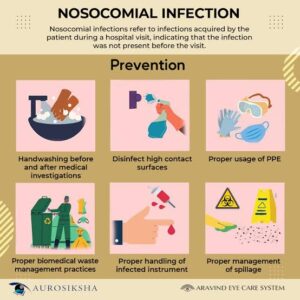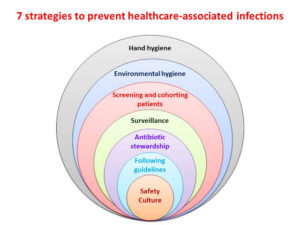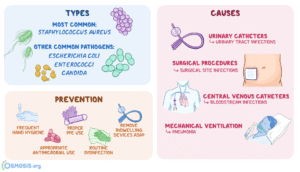Back to: MICROBIOLOGY 300 LEVEL
Welcome to class!
I’m truly happy to have you here again! Today’s topic is one that directly affects patient safety in our hospitals and clinics—Nosocomial Infections and Their Prevention. These infections, also known as hospital-acquired infections, are one of the major challenges in healthcare today, especially in many parts of Nigeria where overcrowded wards and limited hygiene practices can create perfect conditions for germs to spread. So let’s learn how to recognise and prevent them!
Nosocomial Infections And Prevention
What are nosocomial infections?
Nosocomial infections are infections that a patient gets during hospital stay, which were not present or incubating at the time of admission. They usually occur 48 hours or more after hospitalisation, or even after discharge in some cases.
Common examples include:
Urinary tract infections (UTIs) from catheters

Surgical site infections (SSIs) after an operation
Pneumonia, especially in patients on ventilators
Bloodstream infections from intravenous lines
Let’s say a man is admitted at a general hospital in Kaduna for a broken leg. After surgery, he starts running a fever. Tests reveal a wound infection caused by Staphylococcus aureus. That’s a classic nosocomial infection.
Why are they so dangerous?
They often involve resistant bacteria like MRSA or ESBL-producing organisms.
They prolong hospital stay, increase costs, and can even lead to death.

They affect both patients and health workers, and can spread easily if not properly controlled.
Sources and risk factors
Contaminated hands of health workers
Unsterilised instruments or surfaces
Invasive devices like catheters, IV drips, and ventilators
Overuse or misuse of antibiotics
Weak immune systems in patients, especially the elderly or newborns
Prevention of nosocomial infections
Preventing these infections isn’t complicated—it’s about strict hygiene, smart practices, and consistent effort.
Hand hygiene
Regular washing of hands with soap and water or using alcohol-based sanitisers is the single most effective method. Every health worker should clean their hands before and after touching a patient.
Sterilisation and disinfection
All surgical tools and hospital surfaces must be properly sterilised and disinfected. This includes beds, trays, and even stethoscopes.
Use aseptic techniques
During injections, wound care, catheter insertion, and surgeries, aseptic practices must be followed to avoid introducing pathogens.
Limit use of invasive devices
Devices like urinary catheters and ventilators should only be used when absolutely necessary, and removed as soon as possible.
Antibiotic stewardship
Using the right antibiotics for the right infection helps reduce resistant bacteria that cause difficult-to-treat infections.
Isolation of infected patients
Patients with known infections like MRSA should be separated to prevent cross-infection to others.

Education and training
Health workers must be regularly trained on infection control practices to ensure standard procedures are followed.
Summary
- Nosocomial infections are infections acquired in a hospital setting.
- Common examples include UTIs, pneumonia, surgical site infections, and bloodstream infections.
- Prevention involves proper hand hygiene, sterilisation, aseptic techniques, cautious use of invasive devices, and appropriate antibiotic use.
Evaluation
- What is a nosocomial infection?
- Mention three common types of hospital-acquired infections.
- Give two key practices that can prevent these infections.
Each topic you learn brings you closer to making healthcare safer in our communities. Imagine the lives you’ll touch with this knowledge—from preventing infection in a rural clinic to training staff in a busy teaching hospital. Keep going strong—Afrilearn is here for you every step of the way. See you in the next class!
